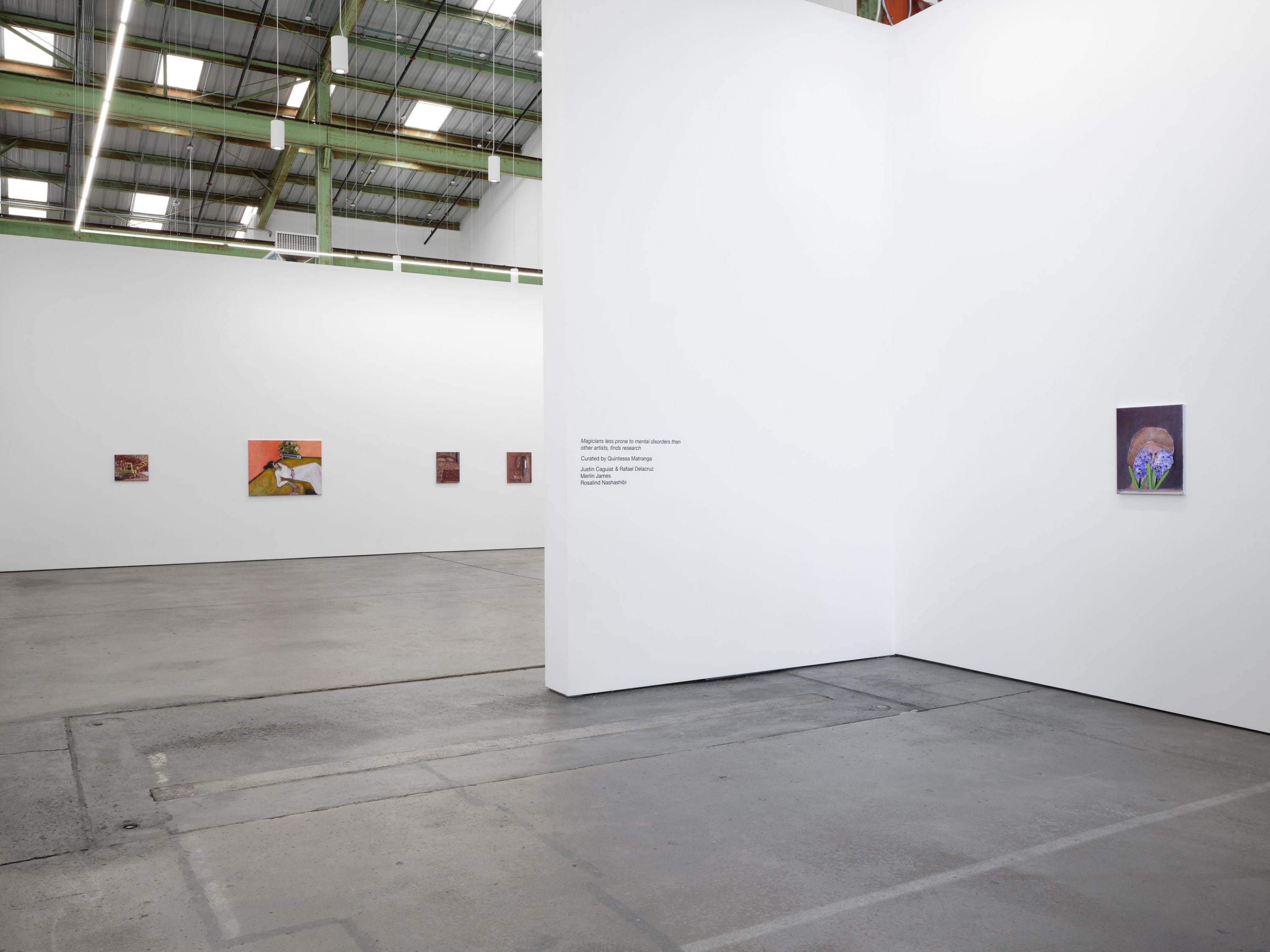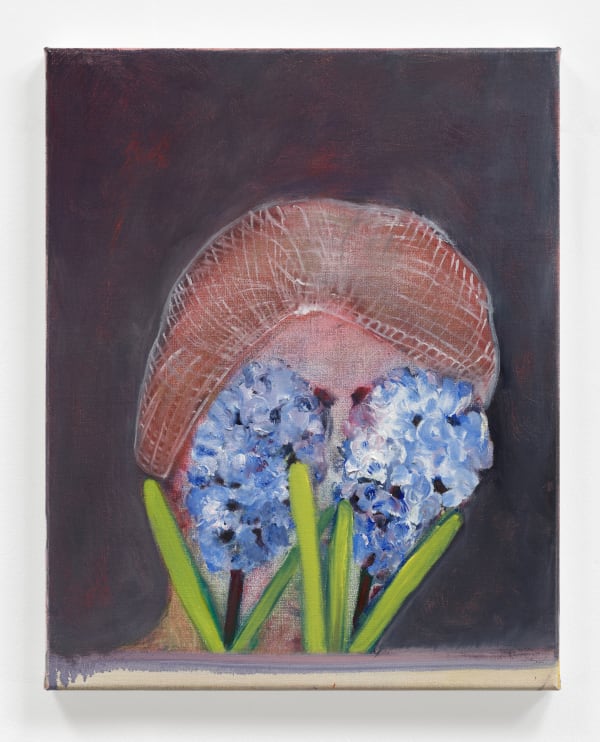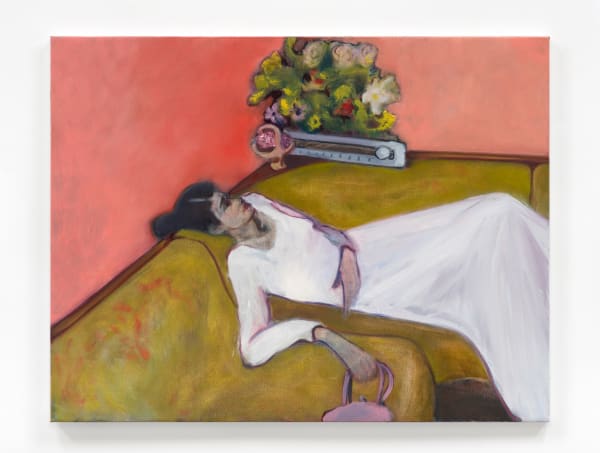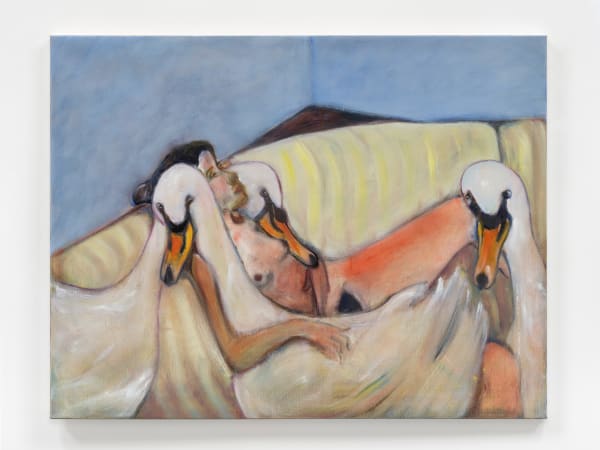-

-
Creative types – musicians, painters, writers – are often regarded as a tormented and difficult bunch but a study has revealed that at least one subsection of the artistic community may have grasped the trick of staying well balanced.
– Steven Morris, The Guardian
-

-
The artists: Justin Caguiat, Rafael Delacruz, Merlin James and Rosalind Nashashibi span diverse working methods to ask what constitutes relevancy, seriousness, or beauty in painting. The works in this exhibition engage personal, art-historical, and mythological subjects as a foundation from which to probe the depths of aesthetic risk. Occupying the threshold between indecent subject and decent painting, or decent subject, indecent painting, these works embody a potency and strength, beyond the boundaries of what an image itself can contain.
-

-
Rosalind Nashashibi confronts notions around the essential act of looking in both her paintings and her films. Engaging a high-risk strategy, Nashashibi tackles themes and motifs that court failure. The signifiers in Nashashibi’s paintings are utilized more as obstacles to viewing an image rather than as escape routes into them. The self-portrait Hairnet and Hyacinths (2024), most directly addresses the problem of viewing. Referencing the Greek myth of Oedipus, whose tragedy concludes in a self-inflicted blinding, the painting depicts a figure whose vision is impeded by two periwinkle flowers. The violence of the pins that Oedipus uses to blind himself in the Greek myth are replaced here by two voluminous hyacinths. The gentle nature of the flower is a humorous, and slightly cheeky path towards neutering the epic masculine tragedy of the myth. In another painting, a woman reclines surrounded by three swans. Swans recall both the subject of a saccharine thrift store tchotchke, and the romantic grandiosity of artists’ adaptations of the Leda myth. Leda, who was raped by Zeus disguised as a swan and later gave birth to Helen of Troy, is a canonical subject that has fascinated artists from Michelangelo to Tintoretto to Rubens to Cezanne. Nashashibi adeptly transposes monumentally loaded art-historical motifs with contemporary modalities, arriving at wholly original images and compositions that test the boundaries between beauty, vulgarity, kitsch, and the embarrassingly exposed.
-
-

-
Justin Caguiat and Rafael Delacruz premier a new collaborative painting for the exhibition. Delacruz’s canvases typically feature dynamic vignettes of everyday life within a vibrant patchwork of color. Caguiat is primarily known for his monumentally scaled unstretched paintings, splayed to their farthest points within the confines of their aluminum frames. In addition to painting, both artist’s work in 16mm film, video, and sculpture and both maintain studios in New York and California. Caguiat & Delacruz’s collaborative paintings demonstrate their shared sense of color and abstracted approach to narrative.
-
-
-

-
-
-

-
Merlin James could be said to paint from the outside in, activating the edges and limits of his works, attending especially to the corners and the sides of his canvases, and often making unconventional, integral picture frames for the works. In addition, he will often paint on semi-transparent materials that half reveal the stretcher behind. James also overpaints and changes his images across extended periods of time and may cannibalize and ‘reincarnate’ canvases over years or decades — even reacquiring works that have been shown and sold, in order to further transform them. In this way he questions where and when a work of art begins and ends, physically and temporally. Resisting a singular stylistic ‘signature,’ James’ imagery includes dark interiors, anonymous landscapes, architectural structures, bridges, animals, erotic figuration, and cryptic, diagrammatic semi-abstraction. One recurrent form his work takes is that of an atmospheric, near-monochromatic seascape. James has said, “Seascapes, especially with moons or suns above, provide a dangerous motif for painting, often descending into kitsch and sentimentality. But there are so many great sea paintings over the centuries. I want to redeem and vindicate the genre.” Though suggestive of the sublime, James’s sea paintings have often been prompted more by pedestrian urban beaches, accessible by public transit, like the coastal estuaries of South Wales, near where the artist was born, Coney Island in New York.
-
-
-

-
-
-
-

-
-
-

-
Press
-
Justin Caguiat (1989, Tokyo, Japan) lives and works between New York and Oakland, California. Recent solo exhibitions include Greene Naftali, New York (2022); The Warehouse, Dallas (2022); Taka Ishii Gallery, Tokyo (2021); Modern Art, London (2023, 2020); and 15 Orient, New York (2018). Significant group shows include Modern Art, London (2023, 2021); Lomex, New York hosted by Arcadia Missa, London (2020); and Clima, Milan (2019). Caguiat is a published poet and has participated in various readings and performances, including in 2017 at the Kunsthalle Zurich, Switzerland. His work is in the collections of the Dallas Museum of Art; the Hammer Museum, Los Angeles; Hessel Museum of Art, Annandale-On-Hudson, New York; Museum of Contemporary Art, Chicago; Museum of Contemporary Art, Los Angeles; and San Francisco Museum of Modern Art, among others.Rafael Delacruz (1989, San Francisco, CA) lives and works between New York and Berkeley, California. Recent solo exhibitions include Cushion Works, San Francisco (2024) Mitchell-Innes & Nash, New York (2023), Franklin Parrasch Gallery, New York (2022) Finn, Detroit (2022), among others.Merlin James (1960, Cardiff, Wales) studied in London at the Central School of Art and the Royal College of Art. He currently lives and works in Glasgow, Scotland. James’ work has been exhibited widely, including in recent solo shows at A-M-G5, Glasgow, UK (2018); OCT Boxes Museum, Shunde & OCT Art and Design Gallery, Shenzhen (2018); Long Game, CCA Glasgow (2016); Kunstverein Freiburg (2014); Parasol Unit, London; KW Institute for Contemporary Art, Berlin (2013). In 2007, James represented Wales at the 52nd Venice Biennale. He also curates the exhibition space 42 Carlton Place, in Glasgow. Solo exhibitions include, Chris Sharp Gallery, Los Angeles; Philadelphia Art Alliance at University of the Arts, Philadelphia, PA; Kerlin Gallery, Dublin, Ireland; Sikkema Jenkins & Co., New York, NY; among others.Rosalind Nashashibi (1973, London, UK) is of Northern Irish and Palestinian heritage. She received her BA in Painting from Sheffield Hallam University, Sheffield (UK) and her MFA Glasgow School of Art, Glasgow (UK). In 2020, Nashashibi was artist in residence at the National Gallery in London (UK). She was a Turner Prize nominee in 2017 and represented Scotland in the 52nd Venice Biennale. Her work has been included in Documenta 14, Manifesta 7, the Nordic Triennial, and Sharjah 10. She received a Paul Hamlyn Award in 2014 and won the Beck’s Futures prize in 2003. Solo exhibitions include; Nottingham Contemporary (UK); Musée Art Contemporain Carré d’Art, Nîmes (FR); Radvila Palace Museum of Art for CAC, Vilnius (LT); Vienna Secession (A); The High Line, New York, NY (US); The Art Institute of Chicago, Chicago, IL (US); Imperial War Museum, London (UK); and ICA, London (UK) among others.Special thanks to GRIMM gallery, Sikkema Jenkins & Co, Greene Naftali for supporting this project.





















